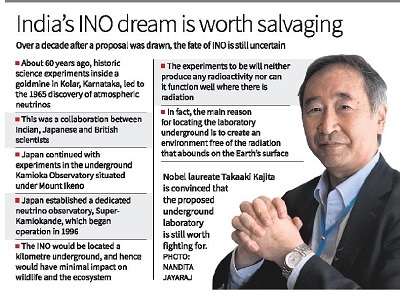Context:
If the obstacle-ridden India-based Neutrino Observatory (INO) ever becomes a reality, it will be one of the largest basic science projects in the country. Nobel laureate and neutrino researcher Takaaki Kajita is convinced that the proposed underground laboratory is still worth fighting for.
The Indian Neutrino Observatory
The Indian Neutrino Observatory (INO) is a proposed particle physics research project aimed at studying neutrinos in a 1,200-meter deep cave. Neutrinos are fundamental particles that are difficult to detect due to their lack of electrical charge and minimal interaction with matter. Despite this, they play a crucial role in elementary physics.
Produced in high-energy processes such as within stars, supernovae, particle accelerators, and nuclear power plants, neutrinos are typically studied using detectors built underground to avoid cosmic rays and background radiation. Around 20 neutrino detectors exist worldwide, mainly observing neutrinos from distant stars and galaxies.
The INO will be operated by seven primary and 13 participatory research institutes, led by the Tata Institute of Fundamental Research (TIFR) and the Indian Institute of Mathematical Sciences (IIMSc). Conceived in 2005, the project faced initial resistance from the Union Environment Ministry in 2009, leading to a site change to Bodi West Hills. Approved in 2015 with Rs 1,500 crore funding, the INO will feature a 50-kilotonne magnet, the largest in the world.
Parallels and Contrasts Between Japan and India’s Neutrino Research
The History and Progression of Neutrino Research
Neutrinos are abundant particles that may be relevant to our understanding of the origin of matter in the universe. About 60 years ago, historic science experiments inside a goldmine in Kolar, Karnataka, led to the 1965 discovery of atmospheric neutrinos through a collaboration between Indian, Japanese, and British scientists. Awakened to the potential of neutrino research, Japan continued with experiments under their soil in the underground Kamioka Observatory situated under Mount Ikeno. This was where a team would discover cosmic neutrinos in the late 1980s. Subsequently, Japan established a dedicated neutrino observatory, Super-Kamiokande, which began operation in 1996. In 2002, a researcher won a Nobel Prize for his contributions.
The Uncertain Journey of India's Neutrino Observatory
Indian scientists had no intention of being left behind. Though the original experiments ended in 1992 due to the closure of the goldmines in Kolar, plans to build an observatory were already underway. After extensive deliberations, a proposal was drawn, and in 2011, the Indian government announced its intention to set aside about Rs. 1,350 crores for an India-based Neutrino Observatory, situated 1.3 km underground in Tamil Nadu.
Over a decade later, there has been no progress, and today, the fate of INO is uncertain. Meanwhile, Japanese researchers received the first evidence for a phenomenon called neutrino oscillation within a year of the Super-Kamiokande. This discovery led to a student of the earlier Nobel Prize winner jointly winning another Nobel Prize in 2015. Having spent his entire research career in Japan, the Nobel laureate exemplifies the benefits of having a neutrino laboratory close to home. “We can easily access the laboratory, and the detector is nearby,” he said during a recent Nobel Laureate Meeting.

Opposition to the INO Project
Radioactivity Concerns
Opposition to the INO project centers on environmental concerns and fears about radiation. Despite assurances from INO scientists that the observatory would be located underground at a depth of one kilometer, minimizing impact on wildlife and the ecosystem, concerns persist. They emphasize on their website that the experiment will not generate radioactivity and is shielded from natural surface radiation. In contrast, the Japanese neutrino project placed their detector in an active mine, avoiding additional excavation. Originally designed to study proton decay, the project was unrelated to radiation. A key breakthrough came with the observation of Supernova 1987A, detected by the Kamiokande-II detector, marking a milestone in cosmic neutrino research.
Ecological Concerns
The proposed INO project site falls within the Mathikettan-Periyar tiger corridor, crucial for wildlife movement. Although experts argue that the deep underground tunnels and laboratory pose minimal risk to tigers and the corridor, the Tamil Nadu government's affidavit highlights potential ecological impacts. It cites concerns over construction activities like blasting and tunnelling affecting wildlife and local ecology. The site connects the Periyar Tiger Reserve in Kerala with Srivilliputhur Meghamalai Tiger Reserve, essential for biodiversity and genetic diversity among tigers.
Benefits of a Neutrino Observatory in India
Proximity to Research Facilities
Establishing a neutrino observatory in India offers local particle physics students access to advanced detectors, eliminating the need to travel abroad. The Nobel laureate, drawing from his own experience in the 1980s, highlights the benefits of proximity to cutting-edge research facilities. Meanwhile, Japan's Super-Kamiokande facility continues to train particle physicists, with some opting to work overseas. Despite declining offers post-Nobel in 2015, the laureate advocates for completing the INO project, emphasising the need to explore further in neutrino physics despite delays.
Contributions to Global Nuclear Physics Research
The INO project, despite facing opposition, holds significant importance for India. It aims to become a premier underground science facility spanning multiple disciplines, including physics, biology, geology, and engineering, thereby enhancing India's scientific capabilities. Alongside the LIGO (Laser Interferometer Gravitational- Wave Observatory) India project, it represents a key aspiration of Indian physicists and promises contributions to global high-energy and nuclear physics research. Moreover, it provides Indian science students with opportunities to engage in cutting-edge technology development, fostering advancements in both scientific research and technological infrastructure.
Conclusion
The India-based Neutrino Observatory (INO) project exemplifies the complex challenges and immense potential of pursuing ambitious scientific endeavours in India. Despite initial promise and renowned supporters like Nobel laureate Takaaki Kajita, the project remains stalled due to environmental concerns and bureaucratic hurdles. The INO project, once completed, can be a turning point for Indian science. It represents a vital step towards becoming a global leader in fundamental research and a testament to India's scientific aspirations. Overcoming delays and public apprehension requires transparent communication, addressing genuine concerns, and highlighting the long-term benefits for Indian science and society. With unwavering commitment and a collaborative spirit, India can finally take its rightful place at the forefront of neutrino research.
|
Probable Questions for UPSC Mains
|
Source: The Hindu







